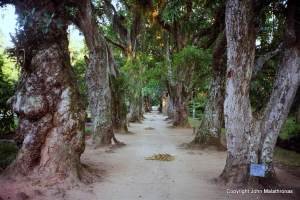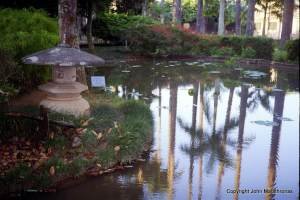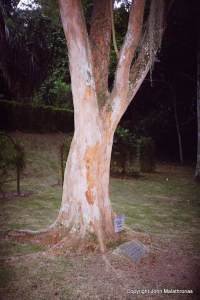To celebrate Rio’s new 2012 Unesco site , I am republishing this condensed passage from my book Brazil: Life, Blood, Soul.
When Portuguese King João VI instituted the Botanical Garden in Rio in 1808, there were many fortunes to be made from the discovery and breeding of exotic plants. There are over 8,000 kinds of plants over an area of 137 hectares which include two museums, a library, a cactus collection, a lanchonete, several romantic alleys, ponds with giant Victoria Regias and two grand glass houses for orchids and bromeliads.
Quiet. How strange it is to find peace in the frantic throb of Rio.
I passed the meditative Japanese garden complete with lotus flower ponds and miniature bridges, mini bonsais and mighty cherry trees in whose blossom Princess Sayako, daughter of the Japanese Emperor, inaugurated the grounds in November 1995; oddly they planted it next to a patch of Amazon rainforest. Snap! There are even mosquitoes here. How authentic.
I walked under mango trees and banana bushes with marmosets and serelepe long-tailed squirrels climbing rapidly up their branches as soon as I appeared. I squinted through the leaves of 65-foot-high cannonball trees with their cascading large brown fruit, rare red aromatic jasmine spilling onto their roots, and the Dutchman pipe flower, ten inches of purple and white veins obstructing my view of the greenhouse in front of me.
If orchids are the world’s most glamorous flowers then Rio’s orchidarium is a veritable Versace of glasshouses: flamboyant and exotic like its contents, it contains some of the most extraordinary examples of orchiddom. Orchids are the most evolved of flowers: they have adapted so that out of millions of insects only one species can pollinate them. This specific insect determines the size of the flower, the colour, shape and odour of the lip and even when the fragrance is emitted (night or day depending on the insect’s habits). Orchids range from tropical scented varieties – vanilla itself is classified as an orchid – to minute seedlings that sprout in snow-clad Siberia. The last sensational orchid to have been discovered in the wild was in Peru in 1980, a flower so red and bright that one marvels it was not discovered earlier. I would add that most orchids are bisexual, but I’m sure you knew that already; I did mention they were highly evolved.
I walked out of the orchidarium and bumped into a group performing t’ai chi by the ruins of an old gunpowder factory which existed before the Rio Botanical Gardens took over; I liked the concept of flowers overrunning a building dedicated to warfare. I looked at my watch. Damn. I wanted to check out the 1,700 species in the bromeliarium next door, but I was miles away from the entrance gate which was closing in half an hour and, well, I still had not found what I’d come for. I rushed through bromeliads ranging from mutant pods with white fur to wide-leafed, harpoon-tipped, red-centred spikes to large mauve watermarked tubers the size and texture of watermelons.
Where is it?
The Victoria Regia pond was drained; the Burle Marx promontory was being reinforced; the cactarium had already shut for the day. The garden for the sightless was a distraction: a touch-and-feel area with signs in Braille containing plants from rosemary and oregano to ginger, basil and cloves. What’s the time again?
There it is.
Sweaty and breathless I stood still, as if to pay homage in front of an unassuming tree hidden under the thick cover of lianas. It was about 30 feet tall, although I had read it can reach up to 90 feet in the wild. It blooms from September to December with lovely yellow flowers. This tree used to reign in the coastal forest in Brazil’s Year Dot; 500 years later, like so many languages and people, plants and animals, it is almost extinct. Its yellow-green bark had been stripped to show a soft reddish interior the colour of a red coal, in Latin brasa, the same root as our brazier. So this is the pau-brasil, the brazilwood tree so prized in the markets of Lisbon. The name ‘brazilwood’ was a generic term used for red dye-wood: Marco Polo himself gave an account of the brazilwoods of Sumatra; Tercéira in the Azores was once called Island of Brazil for the same reason.
And yet, it’s this species that baptised a country.
John Malathronas’s second edition of Brazil: Life, Blood, Soul is now available on Kindle.




I enjoyed this story on Rio’s botanical garden John. Did you know that someone recently included Rio in his list of the world’s 10 worst cities. Can’t recall who it was, but all lists are lazy.
Thanks Christine. World’s worst cities, eh? I don’t think Rio will worry that much!